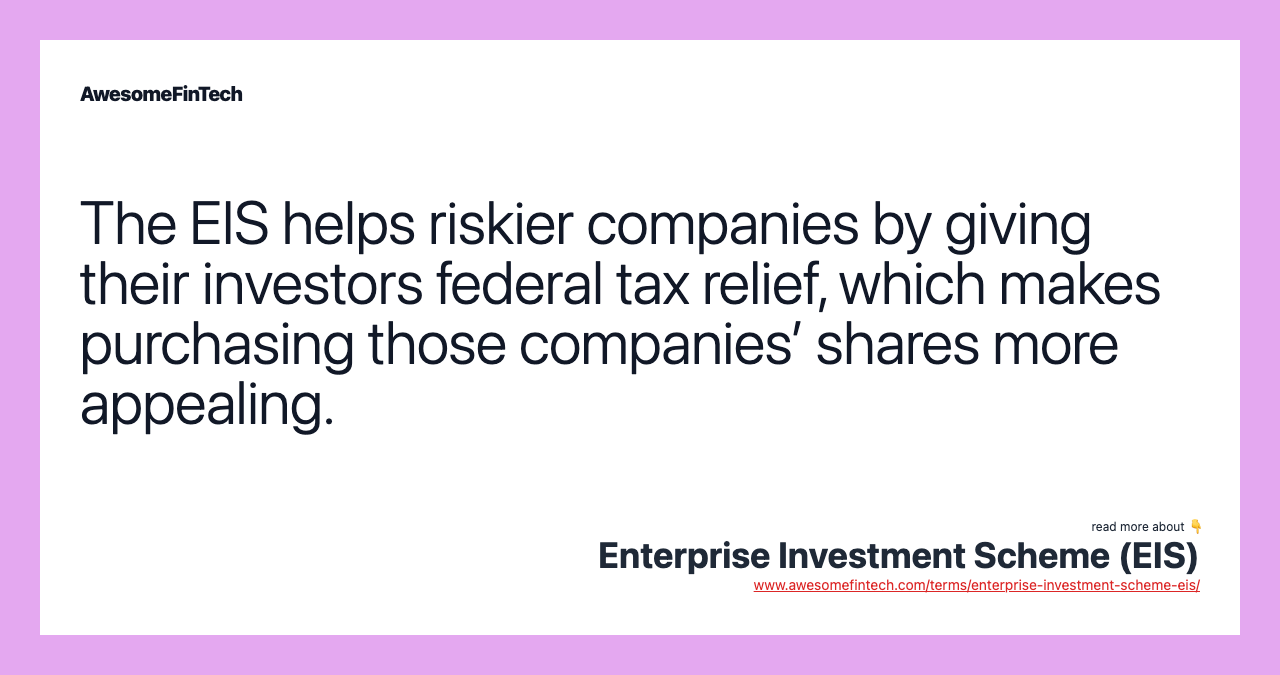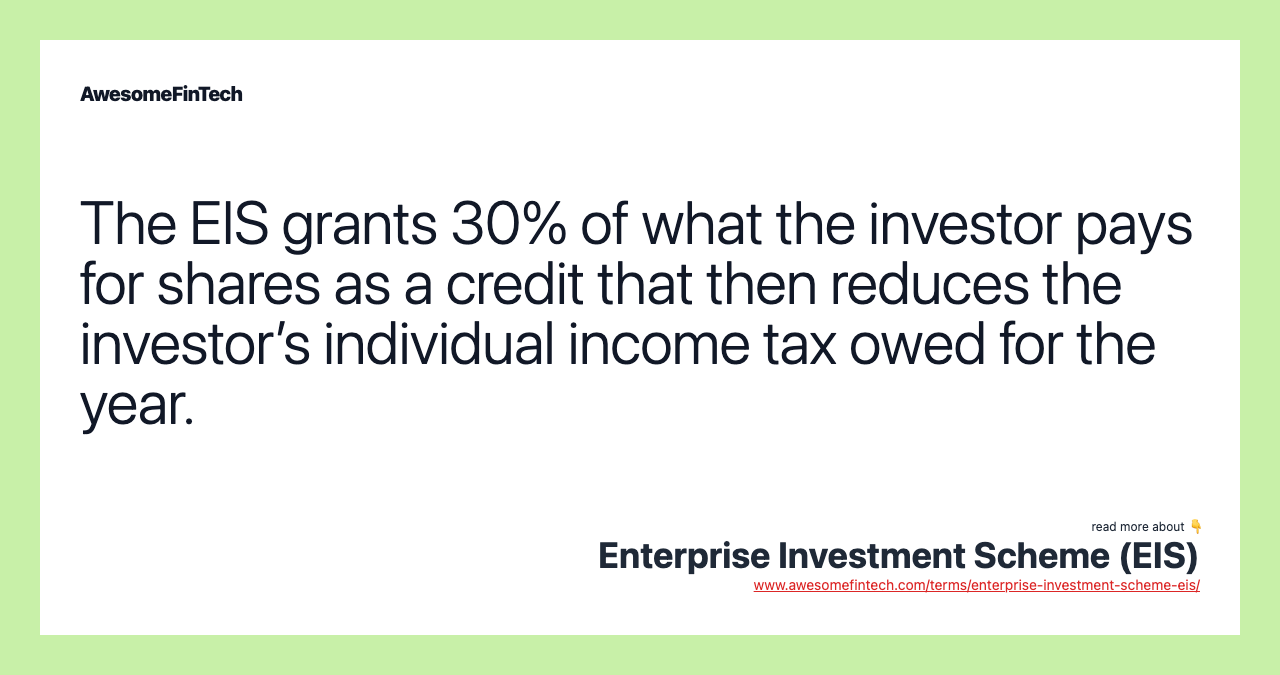Enterprise Investment Scheme (EIS)
Enterprise Investment Scheme (EIS) is an investment program in the United Kingdom that makes it easier for smaller, riskier companies to raise capital. The Enterprise Investment Scheme helps riskier companies by giving their investors federal tax relief, which acts as an incentive to investors, making the potential purchase of those companies’ shares more appealing. The Enterprise Investment Scheme works by granting 30% of what the investor pays for the shares as a credit that then reduces the investor’s individual income tax owed for the year that the individual purchased the shares. The EIS helps riskier companies by giving their investors federal tax relief, which makes purchasing those companies’ shares more appealing. For example, the EIS would restrict investor A from investing in investor B’s company on the condition that investor B invests in investor A’s company in return.

What Is the Enterprise Investment Scheme (EIS)?
Enterprise Investment Scheme (EIS) is an investment program in the United Kingdom that makes it easier for smaller, riskier companies to raise capital. The Enterprise Investment Scheme helps riskier companies by giving their investors federal tax relief, which acts as an incentive to investors, making the potential purchase of those companies’ shares more appealing.



Understanding the Enterprise Investment Scheme (EIS)
The Enterprise Investment Scheme works by granting 30% of what the investor pays for the shares as a credit that then reduces the investor’s individual income tax owed for the year that the individual purchased the shares.
Taxpayers can claim tax relief of 30% on investments of up to £1 million (or up to £2 million if the money is invested in knowledge-intensive companies). Investors In addition to the tax credit, the EIS also eliminates the capital gains tax on those shares when the individual decides to sell said shares. Interested investors can purchase shares of the qualifying companies from them directly or through an EIS fund.
How to Qualify for Enterprise Investment Scheme Tax Relief
In order to qualify for the tax relief, both the companies and their investors must follow many specific regulations. The extensive EIS regulations are meant to prevent companies and investors from abusing the law and subverting its goal of encouraging small business investment.
One of those regulations requires investors to pay for the shares at the time they receive them. Shares issued without payment or with delayed payment are ineligible for EIS tax relief. Investors must hold the shares for at least three years and shares purchased must be ordinary shares that do not preferentially protect the investor from the risks of investing in the company.
The EIS does not allow any arrangements made solely to provide tax relief. For example, the EIS would restrict investor A from investing in investor B’s company on the condition that investor B invests in investor A’s company in return. The EIS also excludes individuals with controlling financial interest in a company from receiving tax relief. Partners, directors, or employees of a company are also excluded.
The EIS allows an exception that applies to angel investors. Angel investors are investors in small startups or entrepreneurs and are commonly an entrepreneur's family and friends. Many consider angel investing to be investing in the entrepreneur starting the business rather than the viability of the business itself; thus, many consider angel investors the opposite of venture capitalists.
In order to claim the tax benefits of EIS, taxpayers must receive Form EIS3 from the company. If the company loses its qualifying status, the investor also loses their claim to tax relief despite having no control over the company’s decisions.
Related terms:
Angel Investor
An angel investor is usually a high-net-worth individual who provides financial backing for small startups or entrepreneurs, usually in exchange for ownership equity. read more
Child Tax Credit
This $2,000-per-child credit covers children under 17; $1,400 is refundable. In 2021, it's $3,000 for under 18s ($3,600 under 6) and fully refundable. read more
Controlling Interest
A controlling interest is when a shareholder, or a group acting in kind, holds a majority of a company's voting stock. read more
Crowdfunding
Crowdfunding is the use of small amounts of capital from a large number of people to raise money or fund a business. Learn the pros and cons of crowdfunding. read more
Entrepreneur & Entrepreneurship + Types
Entrepreneurs and entrepreneurship have key effects on the economy. Learn how to become one and the questions you should ask before starting your entrepreneurial journey. read more
Forbearance
Forbearance is a form of repayment relief involving the temporary postponement of loan payments, typically for home mortgages or student loans. read more
Self-Employment
A self-employed individual does not work for a specific employer who pays them a consistent salary or wage. read more
Subprime Mortgage
A subprime mortgage is normally issued to borrowers with lower credit ratings. It typically carries a higher interest rate that can increase over time. read more
Tax Relief
Tax relief is a government program or policy designed to reduce the total amount of taxes paid by individuals or businesses. read more
Unemployment Compensation
Unemployment compensation is paid by the state to unemployed workers who have lost their jobs due to layoffs or retrenchment. read more